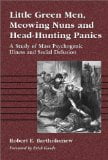 Little Green Men, Meowing Nuns and Head-hunting Panics: A Study of Mass Psychogenic Illnesses and Social Delusion
Little Green Men, Meowing Nuns and Head-hunting Panics: A Study of Mass Psychogenic Illnesses and Social Delusion
by Robert E Bartholomew McFarland and Company, £28.45, ISBN 0786409975
What is happening when scores of women become convinced a phantom slasher is attacking them, or when scores of men are persuaded they are losing their penises?
In the past, the tendency has been to take an all-or-nothing approach: either it’s an event – these things are really happening – or it’s a non-event: they aren’t, it’s sheer fantasy.
This is the common-sense approach, and up to a point, it is a reasonable approach: either the Virgin Mary appeared to Bernadette Soubirous or she didn’t; either Linda Napolitano was abducted by aliens or she wasn’t. But even when investigation reveals that a particular event did not take place in the literal sense, it is not good enough to say that nothing happened: because clearly something happened to make the individuals involved think it happened.
This is why the swing today is towards experience based studies, which start with what the witnesses report, whether or not it has a basis in consensus reality, and take it from there. We are coming to see that erratic and anomalous phenomena – poltergeists for example – can best be understood in terms of human behaviour, but this is not the same thing as saying that the phenomena have no existence apart from the human mind. Rather, it suggests that the human mind is the best place to start looking if we want to understand why these claims are made, and why they take the form they do.
For some time now, Robert Bartholomew has been offering us articles and books helping us to understand strange phenomena by approaching them in this way. His UFOs & Alien Contact (1998, with George S Howard) is of fundamental importance to our understanding of the UFO phenomenon, adopting a global approach to the subject and placing the individual experience in the wider context of psychosocial behaviour.
This new book brings together a number of his papers on specific examples of collective outbreaks which at one time or another have perplexed investigators and set the experts tilting one against another, each mounted on the hobby horse of his choice. He shows how both the popular label ‘mass hysteria’, and the scientific classification ‘mass psychogenic illness’, tend to be used in a careless manner which fails to take into account the social and psychological processes underlying the outbreak. Up to a point it is a thorough-going skeptical book. Was there ever a ‘Halifax Slasher’, did the ‘Mad Gasser of Mattoon’ have flesh-and-blood existence? Were the Swedes overflown by ‘Ghost Rockets’? If you are driving from Esher to Cobham do you risk having your windshield shattered by the ‘Phantom Sniper’? Bartholomew shows that in each of these cases, as in the many others he cites, the culprit was no more real than the devil who copulated with witches at medieval sabbats or the aliens whose flying saucer crashed at Roswell in 1947.
But debunking the myths is not Bartholomew’s primary purpose: he is concerned to lay bare the process whereby such myths come into being. Here he is on contested ground, for theories proliferate in the absence of hard fact. For some, those who subscribe to a collective belief that the aliens are coming to save us are hysterics: they are quite literally sick in their minds. For others, attempts to explain are meaningless, we should be looking for the inner truth which transcends reason and will lead us to a higher level of reality. The teachings of the Catholic Church allow for the possibility that a statue of the Virgin Mary would turn its head to gratify her worshippers. Folklorists and anthropologists interpret such outbreaks as sick-building syndrome or body-part-stealing in relation to their preferred agendas.
Unfortunately, the area is so incompletely mapped that these and other alternative theories are hard to refute; but Bartholomew makes out an overwhelming case for a psychosocial approach. That is, the individual experience takes place because the individual is the kind of person s/he is, and it takes the form it does because the individual lives in a particular cultural milieu which shapes it to conform with prevailing belief systems. For men to start panicking because they seem to be losing their penises may seem absurd to western Europeans, but in the context of Chinese folk-beliefs it is an ever-present threat, too real for comfort.
This is no mere academic study. These things happen – and Bartholomew shows us that they happen far more frequently than most of us imagine. Writing of Epidemic Hysteria in Schools, he writes: “This article is intended to be of practical value for school administrators, teachers, parents, and health professionals who may be summoned to intervene in such cases.” The author himself acted as consultant when such outbreaks occurred in Malaysia. The recent epidemic of Satanic abuse allegations is an alarming reminder that even our ostensibly sophisticated western culture is far from being immune to social delusions whose consequences can be tragically real. Current world events are a fearful warning of the divergence between the world’s belief-systems: vast populations are marching to a different drum than the one we take to be the norm. There is an overwhelming need for the different cultures of the world to understand one another’s viewpoint, and to recognise the fact that to judge events only from the perspective of our own experience can lead to serious misunderstanding. Bartholomew and his various co-authors offer us a timely book which can help us to see that only when bizarre happenings are placed in a psychosocial context – the cultural milieu of those who experience them – can we begin to see them for what they are.



